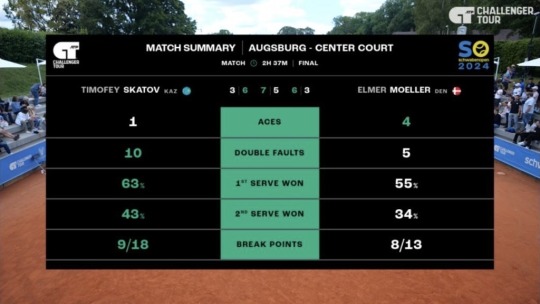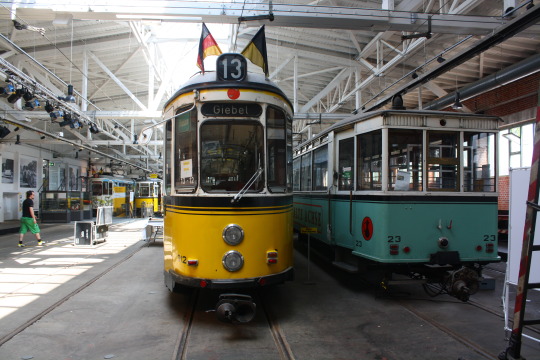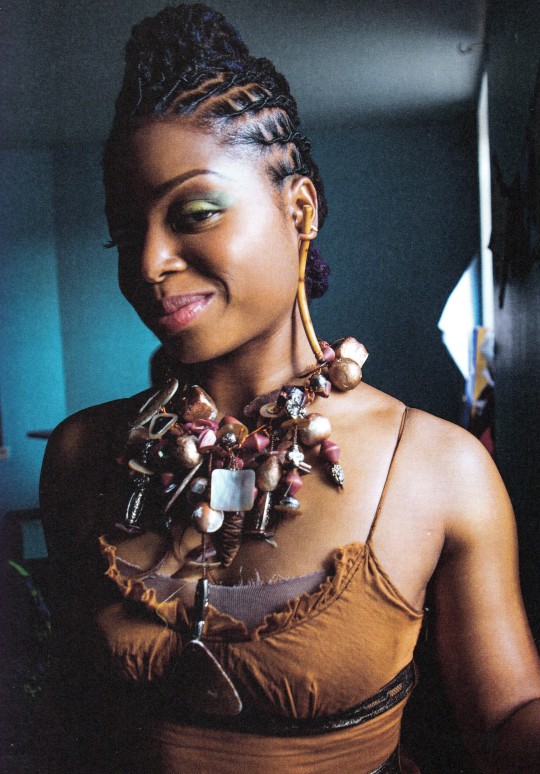#augsburg challenger
Explore tagged Tumblr posts
Text
Augsburg Ch F: Timofey Skatov [1] def. Elmer Moeller [8] 3-6, 7-5, 6-3 Match Stats

📸 ATP official website
This match was a bit of contrasts, with T. Skatov having more reliable forehands while Elmer had more reliable backhands, with consistency being one of the main questions. Somehow, the former managed to maintain his range better after he successfully served it out for the second set, outhitting the eighth seed until he had lesser options while navigating this chaos. As a result, T. Skatov earned 18 opportunities to break compared to Elmer's 13, with the former converting 50% of his break points to maximize his chances.
Besides, T. Skatov turned out to appear more solid in his serves despite all the troubles he faced along the way, likely due to his firmer appearance toward the end of the second set and the match altogether. Even though he scored just an ace than Elmer's 4, T. Skatov won 8% more points behind his first serves at 63%, which helped him avoid some troubles. Even if the first seed double-faulted twice more often than Elmer (10 to 5), he still kept his second serves stable by winning 43% points behind it, 9% more than the Danish eighth seed as a result of the latter's frequent forehand rushes under pressure in its follow-ups.
This marked T. Skatov's second overall Challenger title, his first since winning the Parma Challenger 2022, ending this week in a more competitive note after missing the cut-off to the French Open/Roland Garros qualification rounds earlier this year. He will continue his possible resurgence campaign in the Vicenza Challenger, where he will face Nerman Fatic in the first round, with a chance to face second seed Zsombor Piros in the second round. In Elmer's case, the only way for him is up, as he also entered the Top 300 by landing at 270 by the end of this round.
#atp world tour#atp tour#atp challenger#atp challenger tour#tennis updates#match stats#augsburg challenger#schwaben open#timofey skatov#elmer moeller#WatchChallengersFolks#ChallengerMatters
0 notes
Text









13 days of witches: the Weathermaker of Scholomance
"If I command the moon, it will come down; and if I wish to withhold the day, night will linger over head, and again, if I wish to embark on the sea, I need no ship, and if I wish to fly through the air, I am free from my weight." — Aglaonice of Thessaly
Concealed within the mountains of Romania, deep underground, is said to exist the Scholomance, a school of arcane learning taught by the Devil himself. Ten students are accepted at a time for a period of seven years, during which they are instructed in the secrets of the universe. At the end of this term the Devil selects the most gifted from among the school's graduates to become Weathermaker. The newly-minted Weathermaker, riding on the back of a great, many-headed dragon, flies through the skies bestowing rain and storms, until the next graduate is chosen to succeed them.
#13 days of witches#inspired by interluxetumbra's moodboard challenge#moodboard#witches#witch aesthetic#scholomance#the scholomance#folklore#music#flash warning#image credits:#michaeliantorno.com / thegifsiwanted.tumblr.com / Augsburg Book of Miracles / giphy.com / Philip Dixon for Harper's Bazaar Apr. 1990 /#paytonrabe on pinterest / themakeupbrush.tumblr.com
20 notes
·
View notes
Text

0 notes
Text
Day 1
How did you first discover the Nibelungenlied
So the first time that I remember stumbling upon it I must have been eight or so, sometime in elementary school. My family was subscribed to the National Geographic Kids Magazine, and in Germany they always came with a CD about a rat called Marvi Hämmer (until they stopped doing those around 2014 I think). They always had the same structure which always included a quiz. One of the first issues of that, that I got was about dragons, so of course one of the questions on that quiz was: “what was the name of the dragon killed by Siegfried?” After that Marvi also went into a bit more detail about the story but not that much.
Anyways after that the Nibelungenlied was just a thing that was around for a while. In school there were always some people that did book reports about it, but I never experienced any of those (they were held in different classes), but the posters of such presentations would always hang on some classroom wall for a while. Our teacher also once gave us a brief plot summary in school but it was nothing too important. And I can’t really remember if this was the case but I think the first stanza of the Nibelungenlied: “Uns ist in alten maeren wunders vil geseit” etc. must have been printed in at least one school book, because when I later read the text for the first time, I immediately went: “Wait I know this. I’ve read this before.”
So when I was about 14 I was gifted a children’s version of the Nibelungenlied written by Auguste Lechner. I say children’s version, but it was really just exactly the Nibelungenlied written in modern German prose with relatively easy language. The people who gifted it to me were family friends who had that sort of: “this is so you can read proper literature instead of your fantasy stuff” attitude about it, which is extremely funny in hindsight. But anyways since then I’ve known the complete plot of the Nibelungenlied without ever really having read it.
Then after 2022 something happened which would later make me read the actual Nibelungenlied for the first time. In the time between when I graduated and when I started my first semester at university one of my hometown’s two amateur theatre groups decided to perform a production of the Nibelungen Mythos. It was called “Das Ding der Nibelungen”, had no relation to Wagner’s “Der Ring der Nibelungen” whatsoever, but was instead a comedy about the Nibelungenlied. It was really really bad, and I’ll get into why in one of the later days of the challenge but it was so bad that after it was over I started ranting to my dad about just how bad it was. It was a really nice conversation and we ended up forming some headcanons together. This was when I realized, maybe for the first time, that I actually like the Nibelungenlied a lot.
Then finally about half a year later, it was during my first semester of university, I went into Augsburgs public library for the first time (because I moved there) and found the Nibelungenlied, original text and modern German translation by Ursula Schulze, just lying there. In plain view on a shelf. So I borrowed it, took it home and then finally read the Nibelungenlied for the first time.
Technically the story doesn’t end there because I later found out that what I read was the manuscript C of the Nibelungenlied instead of the manuscript B which is the most commonly discussed one, an probably the one you’ve read, but I have yet to read that (and also other things), and this is getting way too long anyway, so I think that I’ll just stop here.
7 notes
·
View notes
Text
03.10.24 | things done today:
📚 English
read In The Heart of The Sea by Nathaniel Philbrick (ch. 1)
clozemaster
📚 Spanish
clozemaster
read Diarios Completos de Sylvia Plath (p.195-201)
writing challenge
📚 French:
read le trésor du moine ; 6th episode (textbook parcours civilisation)
read an article | les jardins et le parcs de la france
clozemaster
📚 German
unit review (textbook vol. I)
reading & translation | Peace of Augsburg (textbook literature & history)
📌 Extra activities
🍄: how mushrooms grow | mycology 101
📖: L'Impavida by Rita Coruzzi
📻: ► FNV Old World Blues DLC: Mysterious Broadcast Instrumentals (Jazz)
4 notes
·
View notes
Text
German street car lights
I researched this for my own reasons (that I may post about later), but I decided to put it here so I don't forget it.
Headlights. Taillights. We know how they work, we've all seen cars before. White in front, red in back, orange turn indicators, braking makes red extra bright. But for streetcars it's not always quite that simple, which makes modelling a challenge.
First of all, front: All cars and trucks and indeed all modern streetcars have two main headlights, side by side, roughly at the outer edges of the vehicle. Modern german streetcars actually have a third headlight up on top, legally required but barely visible. In this picture of a TW 6000 from Hanover (don't worry, the track curves away there, I was well clear of where the train could travel), it's the tiny little lamp above the destination display.

The idea is to make streetcars like big trains, which (in Germany, and for new trains in all of Europe) have three white lights in an upside-down V configuration in front (exceptions apply). The third light is supposed to make it clear that the thing hurtling towards you is a train. I'm not sure how well it works in this case.
But that is a fairly recent thing. For a really long time, well into the 1970s, the standard was a single central headlight. Consider this train in Vienna (note the pride flag, not relevant, just for fun):

This is a type E₂ train, first introduced in 1978, still in use today (though probably not for much longer, if you're in Vienna and you see one of them, take a picture).
Now, Austria isn't Germany, but the standards between the two countries weren't that wildly different. As far as I can tell there was no one time when dual headlights were introduced; some cities bought trains with two headlights, some with one, often at the same time. The E₂ here was sold with single headlights to Vienna, Braunschweig, Augsburg, Duisburg and a couple of others, but also with dual headlights to Düsseldorf.

In fact, there was even a dual headlight version for Vienna, but specifically only for the Wiener Lokalbahnen, a sort of interurban railway that used streetcar tracks at the Vienna end of its route. This seems to have been a common division of headlights: Single for the purely city routes, double for the longer-distance ones, until everyone standardised on double, eventually with the third headlight on top.
For added confusion, some cities, most notably Stuttgart and Hanover, used double headlights stacked on top of each other. I assume that's meant to count as one headlight, just doubled up in case one burns out.

A very rare specialty: Two headlights side by side but mounted centrally, seen in Frankfurt am Main and I don't think a lot of other places. It's not relevant, I just want to show it because it looks so silly.

Picture: TdVG Harthweg M+m.jpg, © MdE on Wikimedia Commons and Wikipedia-DE, License: CC-BY-SA 3.0 DE
Next, turn indicators. All trams have turn indicators on their sides, generally at window level, but within the window level it's anyone's guess. Some place them near the roof, some more near the middle or bottom of the windows, it seems to be whatever the operator prefers. Turn indicators at the front, near the headlights, are surprisingly not that common. Most single-headlight trams don't have them, the turn indicators on the side have to be enough.
However, the turn indicators are often found at the rear of the train, and that also puts them on the front of dual-direction vehicles (which many trams aren't). See this Frankfurt trailing car, which can only run at the end of the train:

Picture: H-Beiwagen Schwanheim 01052009.JPG, © Urmelbeauftragter on Wikimedia Commons and Wikipedia-DE, License: CC-BY-SA 3.0 unported
You see two red tail lights, and two orange blinker lights. And, in fact, on a dual-direction train from Frankfurt, you'll see the same lights on the front:

Picture: Peter Stehlik 2012.02.18 015a.jpg, © Peter Stehlik on Wikimedia Commons and Wikipedia-DE, License: CC-BY-SA 3.0 unported
But this wasn't always the case. Consider the SSB B2 trailing car from Stuttgart. It has neither motor nor cab, and must always appear at the end of a train. Despite this, it has a (single) headlight for some reason. Perhaps for when the train needs to back up? Below it is a single red tail light. The two other red things near the coupler are just reflectors.

Actually, is that a red tail light? I took that picture in 2013, so it's been a while, and it looks pretty orange, both here and in some historic pictures, e.g. this one from 1979:

Picture: Stuttgart-ssb-sl-2-bw-654287.jpg, © Kurt Rasmussen from bahnbilder.de, found on Wikipedia, licensed for any use as long as the author is credited
Colors on old photographs are a bit of a crap shoot, and in newer videos the B2s definitely have red tail lights, like here:
youtube
But in that video it also doesn't have a headlight, so who knows what rebuilds that one in the video has been through.
Of course, if it's a single orange light, that raises the question: What's that for? Orange tail lights? As far as I can tell, probably not. In fact, a combination that is surprisingly not that uncommon is a single red and a single orange tail light, e.g. here on a historic tram in Nuremberg.

That yellow/orange light is not the "backwards turn indicator". It's the brake light.
Yes, orange brake lights used to be a thing in Germany. For cars, they were phased out in the 1960s. I think historic cars are still allowed to have them, if you can find one. For streetcars, they were phased out a bit later.
Specifically, 2016.
Until then it was legal and very common to have yellow brake lights on trams, even some very modern ones. These are usually combined with the rear turn indicators: If they both light up steadily, the tram is braking, if they're blinking, the tram is about to turn. According to Wikipedia, if it's braking and turning, then one light will light steadily, the other will be blinking, similar to those red turn signals some cars in the US use.
Note, however, that "make the red tail light brighter" (or "turn it on") seems to have been absolutely legal as well, just not super popular. This video from 1974, the final year of the streetcar system in Aachen shows both types of brake lights in action:
youtube
At this point the streetcar network in that city was in terminal decline, and all the cars there were either second-hand or cheaply rebuilt 1950s stuff, so it makes sense that the lighting system was all over the place.
Final note because it didn't fit anywhere else: A single giant tail light, at least on trailer cars, doesn't seem to have ever been used in Germany, but it was not uncommon in Austria.

Picture: Wien-wvb-sl-5-c2-567109.jpg, © Kurt Rasmussen from bahnbilder.de, found on Wikipedia, licensed for any use as long as the author is credited
Other note: It seems that side turn indicators on trailer cars were optional at times. Weird.
So why do you need to know all of that? You don't. I never said you did. I did, however, because I'm currently modifying some trams for my model railroad with better lighting functions, and I wanted to know what the end result should be. The answer is, apparently, "do whatever you want", which is frankly very liberating.
I want to make it clear that this is not an expert or well researched piece. These are just the notes I made in my head while I was trying to figure this out. I almost certainly got things wrong, and I definitely missed some nuances. If you happen to know any, or can give more information on what it was like in your country, or you just feel like it, any comment/reblog with notes/anon hate is absolutely appreciated.
All pictures where no source is mentioned are © me. Use them under CC-BY-SA 3.0 if you want.
8 notes
·
View notes
Text
Today in Christian History

Today is Tuesday, October 31st, 2023. It is the 304th day of the year (305th in leap years) in the Gregorian calendar; 61 days remain until the end of the year.
415: Co-emperors Honorius and Theodosius II issue penalties against Montanists and against any land-owner who permits them to assemble on his property. Montanist meeting places are to be turned over to orthodox churches.
1517: Martin Luther (pictured above) nails a challenge to a debate on the Wittenberg church door. It consists of ninety-five statements, or theses, against the practice of indulgences—theses which he is willing to defend. The theses will be widely distributed and precipitate the Reformation.
1731: Catholic archbishop Leopold von Firmian of Salzburg, Austria, issues an edict expelling all Lutherans from his territory. About twenty thousand people have to leave. Many have nowhere to go and freeze to death in the coming winter.
1754: Provost Acrelius writes to the Consistory of Upsala, requesting the suspension of Rev. John Lidenius from the Swedish ministerial office because he preaches in English.
1772: Thomas and Samuel Green of New Haven publish “A Sermon” by Indian preacher Samson Occum which he had given the month before at the hanging of an Indian man for murder. The sermon becomes wildly successful, going through ten editions in eight years.
1816: Robert Moffat sails for South Africa where he will establish a mission work. Mission leaders had been reluctant to send him, believing he was unqualified. He will become a world-famed mission leader.
1832: George Washington Doane is consecrated Episcopal bishop of a diocese in New Jersey. He will be remembered by Christians for his hymns, especially “Softly Now the Light of Day.”
1871: Vasilii Ivanov is baptized in Tbilisi, Georgia, in the Kura River, an event considered the starting point of the Baptist movement in Azerbaijan, because he will spread the Baptist faith throughout Baku province.
1877: Samuel Schereschewsky is consecrated Anglican Bishop of Shanghai. Developing Parkinson’s disease, he will resign his position, and spend the rest of his life completing a translation of the Bible into Wenli (a Chinese dialect), typing hundreds of pages with the one finger that he could still move.
1879: Death of Jacob Abbott, American Congregationalist author. He wrote many groundbreaking works of children’s fiction, including the instructional Rollo series and the warm Franconia novels.
1920: Baptism of Spetume Florence Njangali in Saint Peter’s Cathedral, Hoima, Uganda. She will become a leader in the effort to obtain theological education for women and their ordination as deaconesses in the Anglican church of Uganda.
1992: Pope John Paul II admits that the Roman Catholic church erred three hundred and sixty years earlier when it condemned Italian astronomer Galileo.
1999: Catholics and Lutherans issue a joint statement on justification in Augsburg, Germany, declaring that “a consensus in basic truths of the doctrine of justification exists between Lutherans and Catholics.”
2010: Islamic terrorists besiege Our Lady of Perpetual Help Church in Baghdad, massacring most of the 120 worshipers inside, including a three year old boy who pleaded with them to stop killing.
14 notes
·
View notes
Note
Do you have more headcannons of Bohemia x Nyo HRE?
Hello!!! And yes, I do have other headcanons regarding the ship. Ship: Bohemia/Czechia x Female Holy Roman Empire/Holy Rome I think Bohemia/Czechia would be the first one to confess out of the two of them, and considering how society viewed relationships of the same sex and how religious the Holy Roman Empire was, they would probably deny their romantic feelings for each other at the beginning. Fortunately, Bohemia had always been bolder, so she eventually accepted what she felt for Nyo!HRE and confessed, but the latter would still be in denial and would even chastise her subordinate for what she felt. Bohemia would defend her feelings and would ask whether or not Nyo!HRE loved her back, which Nyo!HRE would have a hard time answering because her feelings were in conflict. Ultimately, she would settle with the answer "no," but Bohemia believed that her feelings were actually reciprocated and Nyo!HRE was merely refusing to acknowledge the truth. The confession and what happened afterwards would strain their relationship. But after some time, with much consideration, Nyo!HRE also acknowledged the truth, that she did love Bohemia as well, although not without fears. But they had one other to soothe their fears. Their relationship would be a secret to protect it. They might just be very close friends to outsiders, but what they did not know (and thankfully did not know lest they interfere) was that the women were lovers behind closed doors. Bohemia and Nyo!HRE would also have conflicts throughout the span of their relationship, just like other couples. The Bohemian Reformation and the Protestant Reformation might complicate things between them, but Nyo!HRE also had troubles with the Church and the Peace of Augsburg happened, so I believe they would reach an understanding. Of course, there were also other Protestant-Catholic related challenges they had to face, such as Emperor Ferdinand II's antagonistic actions towards his Protestant subjects, the Defenerestation of Prague in 1618, and the Thirty Years Wars, which caused devastating damage to the Empire. - I must admit that my knowledge regarding the events mentioned above was not enough, so I didn't go into detail and had uncertainties. Now, into the positive side of their relationship, I like to think of them doing experiments together or being "science buddies." This idea was inspired by the very little information I read about Emperor Rudolf II whose court was colourful and located in Prague. Bohemia also gave me the impression that she would be more openly affectionate and take the initiative in giving romantic gifts more often. But, rest assured, that Nyo!HRE loved her equally and would not allow herself to be outdone by her beloved handmaiden in the act of gift-giving! So expect Bohemia to be showered with much more gifts. And another idea I like is Bohemia teasing Nyo!HRE by using her honorifics and kissing her skin when she was alone in helping her prepare for the day or night. For instance, when she was assisting Nyo!HRE in wearing or removing a necklace, she would kiss her nape all of sudden, making Her Majesty very flustered. Nyo!HRE would also often invite Bohemia to sleep with her in the same bed given the chance, and Bohemia had a reason to be in her bedroom anyway, being her personal attendant and a favourite one at that, which others were perfectly aware of.
#hetalia#hws holy roman empire#aph holy roman empire#nyo holy roman empire#hws czechia#hws czech republic#aph czechia#aph czech republic#hetalia headcanons#holyczech
2 notes
·
View notes
Text
Possible Outcomes of a Second Trump Presidency
Here are different scenarios I could see happening, from most likely to least likely.
Cuius Regio, Eius Religio (likely)
Conservatives will implement their agenda in Red States, but will leave Blue States largely alone. We already see this currently with abortion, expect to see the same with LGBT rights, education, etc. The consolation in this case is that adults will at least have the option to move to different states. (It will be curious if conservatives will manage to get universities in Red States under control without downgrading them to propaganda institutions.) If that happens, I suspect that future Democratic presidents will accept this state of affairs. Trying to regain influence in Red States through the federal government risks Republicans trying to do the same. If progressives want to make gains, they will have to do it on the state level.
This Compromise wouldn't last forever, but probably several decades.
("cuius regio, eius religio" was a compromise formular during the Reformation at the Peace of Augsburg 1555 in th Holy Roman Empire. The rulers of the different principalities were free to decide between Catholicism and Lutheran Protestantism and their subjects had to follow their decisions. This peace lasted for ~60 years and was then challenged in the Thirty Year War. After a lot of bloodshed the Peace of Westphalia followed similar principles and the principalities became de facto sovereign.)
Unrest (plausible)
If conservatives don't restrict their agenda to Red States, there will be a lot more resistance. For example, imagine a national abortion ban or mass deportations of immigrants. Then some Blue State officials decide to not enforce these/stand in the way of enforcement. Trump uses the power of the federal government to try to enforce his orders in Blue States. Massive demonstrations with regular violent clashes ensue. Trump stays within law and norms in these attempts, so he doesn't succeed in enforcing his will in Blue States. This situation just goes on for his entire presidency.
In this case at the end of his second term Trump will end similar to George W Bush. A failure. And people will look with hope on the next president (almost certainly a Democrat) who will promise a return to peace and normalcy. But some of the conservative victories will probably stick.
Dictatorship (very unlikely)
Imagine the Unrest scenario, but Trump pushes harder in the end. That means replacing Democratic officials (including governors) who oppose his agenda and suppressing demonstrations. Would require the loyalty of the military.
Anti-Trump Mutiny (very unlikely, on the same level as dictatorship)
Trump attempts to do the dictatorship stuff, but the military refuses to comply. Trump is pressured into resigning or Congress removes him from office.
Civil War (extremely unlikely)
I could imagine three ways a civil war could start:
Dictatorship scenaro, but progressives arm themselves and start and urban insurgency
Anti-Trump Mutiny scenario, but conservatives start a rural insurgency
Either of the above, but the military is split on if it stays loyal to trump.
So I would say the nightmare scenarios are quite unlikely. If Trump is elected, I think progressives have a good shot at defending what they have achieved in Blue States and that is what they should probably focus on. Those who live in firmly Red States might need to move to Blue States though.
(Well, so far for my speculations for now. I might write more posts like this, one about how a second Trump term could play out on the international stage, and one about how a second Biden term could play out.)
2 notes
·
View notes
Text










All-American volume thirteen Born ready
A Journal by Bruce Weber
TeNeues, Augsburg 2013, 200 pages, 24.66 x 31.7 cm, Softcover in decorative slipcase, ISBN 978-3832797355
euro 30,00
email if you want to buy : [email protected]
All-American XIII was a volume in Bruce Weber's annual survey of American legends. That year's theme was "speak up" and features an eclectic array of activists and actors, musicians and writers, newcomers and veterans who proudly share their unique - and out-spoken - visions. After all, free speech and diverse opinions are integral parts of the nation's heritage. This book is a tribute to all those who stand up to share their stories with the world - inspiring, entertaining - and at times challenging us. One thing is certain: when these compelling individuals speak up, you just have to listen.
18/08/23
orders to: [email protected]
ordini a: [email protected]
twitter:@fashionbooksmi
instagram: fashionbooksmilano
designbooksmilano
tumblr: fashionbooksmilano
designbooksmilanoillustration books
#Bruce Weber#All-American#volume XIII#speak up#American legends#activists#actors#musicians#writers#photography books#libri fotografia#fashionbooksmilano
13 notes
·
View notes
Text




📸 🎥 ATP official website
After the chaotic second set, T. Skatov appeared firmer in the third set. Forcing the deuce through his forehands, T. Skatov ended up breaking early to 1-0 as a result of Elmer's double fault, followed by a consolidation to 2-0. He had not looked back since, but Elmer attempted to get back to the match through his forehand pass to finish a rally several moments after his drop shot, only for his forehand errors to take over for T. Skatov's break point before the Kazakh eventually doubled the break to 5-2.
As a result, T. Skatov earned an opportunity to serve for the championship. However, an erratic service game topped by a forehand return ace from the Danish eighth seed resulted in the latter's break-back, with a concern of a possibly rollercoaster akin to the second set. T. Skatov then bounced back as he finished the post-drop shot points through his backhand pass, firing another forehand winner before Elmer's double-fault secured the first seed the third set 6-3, as well as his first Challenger title in two years.
#atp world tour#atp tour#atp challenger#atp challenger tour#tennis updates#hot shots#break point#match point#augsburg challenger#schwaben open#timofey skatov#elmer moeller#WatchChallengersFolks#ChallengerMatters
0 notes
Text

Mrs. Miriam G. Locke, 93, departed from those she loved on Tuesday, January 10, 2023.
Miriam was born on February 19, 1929, in Jacksonville, Florida, to the late Lessie Gertrude Patrick Glover. In 1946, she graduated from Leon High School in Tallahassee, Florida. In 1951, Miriam graduated from Bob Jones University (Greenville, South Carolina) with a degree in Speech and English with an endorsement to teach high school. In 1955, she earned a Masters Degree in Speech Pathology from Florida State University. From there, Miriam's career took her to the Air Force Dependent School in France, Germany, and Japan. In 1958, she returned to the States by going around the world alone at age 29. The next three years were spent as a Speech Language Pathologist in Cincinnati, Ohio. By 1961, Miriam decided it was time to return overseas to teach. This time, she worked with Army schools in Seoul, Korea and Mannheim as well as Augsburg, Germany. Miriam later transferred to Quantico, Virginia and continued teaching in the Federal School System.
In 1976, while still teaching in Quantico, Miriam met the love of her life, Barrie B. Locke. They were married in Washington, D.C. in 1977. Her work continued at Quantico ending 36 years of Federal Service. Her unending desire to teach took her to Stafford County Public Schools where she was employed as a Speech Language Pathologist until she retired with a teaching career spanning over 52 years.
Miriam's favorite past time was knitting everything from scarves, sweaters, blankets, and hats. She also enjoyed the challenge and received the title of Master Knitter. Miriam thrived on perfection in any project she elected to take on. Her teddy bears with movable legs, arms, and heads were exceptional works of art.
Miriam never knew a stranger and she befriended hundreds along the way. She loved her family, especially cousin Lenas Nichols, who was like a brother. She lived three years with Lenas and his family in the early years of her teaching career.
Miriam and her husband, Barrie, raised and sold "Rag Dolls" which were a rare breed of cat noted for their sweet temperament, beautiful coats, and their acting like a ragdoll when held. She loved life and sharing it with Barrie. They were inseparable. Wherever you saw one, the other was always not far behind.
She leaves behind the love of her life and husband, Barrie; and a number of treasured cousins and special friends.
In addition to her mother, Miriam was preceded in death by her sister, June Glover.
A graveside service will be held at 11:30 a.m. on Thursday, January 19, 2023, at Quantico National Cemetery.
In lieu of flowers, donations may be made to St. Jude Children's Research Hospital in Richmond, Virginia.
#Bob Jones University#BJU Hall of Fame#Obituary#BJU Alumni Association#2023#Miriam Glover Locke#Class of 1951
2 notes
·
View notes
Text
Germany divided over potential delivery of long-range Taurus missiles to Ukraine
Germany's Chancellor Friedrich Merz recently announced he would not publicly lead the debate on delivering long-range Taurus missiles to Ukraine. However, as reported by NTV, these discussions are already in full swing, particularly within the Chancellor's own party, with increasing calls for missile deliveries to Ukraine.
The CDU/CSU circles are voicing growing demands for providing Ukraine with long-range weaponry. Roderich Kiesewetter, CDU's foreign policy expert, told Augsburger Allgemeine that it's finally time to prepare and deliver the Taurus system. He asserted that these missiles could "at least partially alleviate challenges" and thereby help protect Ukraine's civilian population if provided in large quantities.
CDU policymaker and Chairman of the Bundestag's Defense Committee, Thomas Rehoukamp, echoed this perspective. In an interview with Frankfurter Allgemeine Zeitung, he stated, Merz "dismissed the range limitation argument by calling for its removal." Although Rehoukamp noted this isn't a commitment to provide Taurus missiles yet, he emphasized that the reason behind previous denials no longer stands.
Anton Hofreiter, a Green Party politician, also supported the missile delivery. He termed Merz's statement as smoke and mirrors unless Taurus cruise missiles were shipped. He insisted, during an interview with Rheinische Post, that only Taurus could effectively target key Russian military nodes in border regions.
Security expert Nico Lange elaborated on ntv.de that Merz's statement is meaningful only if Germany delivers weapons and ammunition with long-range targeting capabilities to Ukraine. Lange is convinced that delivering Taurus still makes military sense.
"Recent airstrikes on Kyiv stress Ukraine's ongoing air defense challenges," Lange noted. "Believing all threats from missiles and drones can be countered is unrealistic. A device like Taurus could threaten runways launching Russian aircraft and later firing over Ukraine. This would vastly aid in strengthening air defense."
In contrast, Sarah Wagenknecht, leader of the pro-Russian leftist party "Alliance of Sarah Wagenknecht" (BSW), criticized the provision of such long-range armaments.
Meanwhile, at "European Forum WDR 2025" in Berlin, Chancellor Merz stated that "range restrictions no longer exist" on weapons to Ukraine—from the British, French, nor Americans, nor from us.
Previously advocated by Merz, the Taurus cruise missile delivery is now left within broader discretion. Under his government, details on specific military systems supplied to Ukraine would no longer be openly disclosed.
However, Germany later dismissed claims over lifting weapon range restrictions for Ukraine. Media sources report no decision has been reached on delivering Taurus long-range cruise missiles to Ukraine. It's unlikely any decision will coincide with Ukrainian President Volodymyr Zelensky's Berlin visit on May 28.
0 notes
Text
Sure straight win for today,
Sure straight win for today,
When it comes to betting, finding sure straight win predictions can be challenging. However, with careful analysis, team statistics, and expert insights, we can increase our chances of making accurate picks. Today, we have selected some of the best straight win predictions based on team form, head-to-head records, and performance trends.
Top Straight Win Predictions for Today
Here are some carefully analyzed matches that have a high probability of winning:
Manchester City vs. Burnley – Manchester City to Win
Man City has a strong home record.
Burnley struggles against top teams.
Real Madrid vs. Getafe – Real Madrid to Win
Madrid has won their last five meetings.
They are in top form and have a solid squad.
Bayern Munich vs. Augsburg – Bayern Munich to Win
Bayern has a dominant home record.
Augsburg struggles in away matches.
Juventus vs. Empoli – Juventus to Win
Juventus has been in great form.
Empoli is weak against strong opposition.
Betting Tips & Strategy
Do Research – Always check the latest team news, injuries, and suspensions.
Check Head-to-Head Stats – Some teams consistently dominate others.
Consider Home & Away Form – Teams perform differently based on location.
Stay Disciplined – Bet responsibly and avoid emotional decisions.
Final Thoughts
While no bet is 100% guaranteed, using expert analysis and proper strategies can increase your chances of winning. These straight win predictions are based on thorough research and expert analysis. Always gamble responsibly and only bet what you can afford to lose.
0 notes
Text
08.10.24 | things done today:
📚 English
read In The Heart of The Sea by Nathaniel Philbrick (ch. 1)
clozemaster
📚 Spanish
podcast
clozemaster
read Diarios Completos de Sylvia Plath (p.211-216)
writing challenge
📚 French:
ordinal numbers (textbook grammar & lexicon)
read an article | paris 🗼
clozemaster
📚 German
weather vocabulary (textbook vol. I)
dictation exercise
reading & translation | Peace of Augsburg (textbook literature & history)
📌 Extra activities
Women Who Run With The Wolves | ch. 5
drawing
📖: Black Fountains by Oswald Wynd
2 notes
·
View notes
Link
0 notes